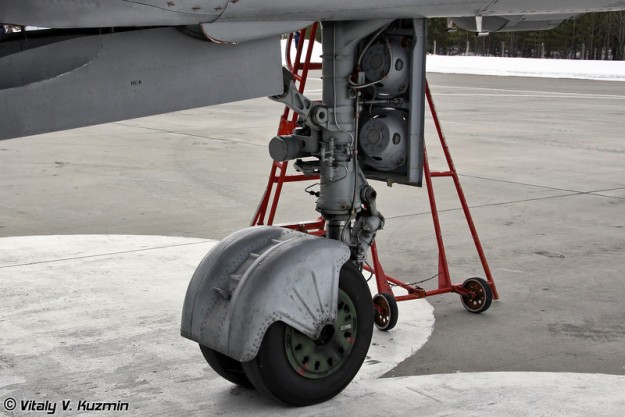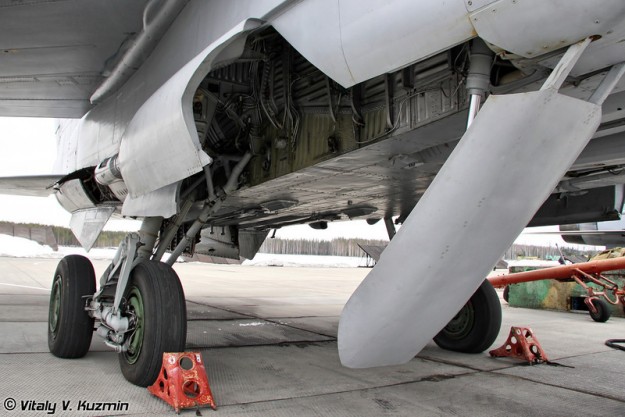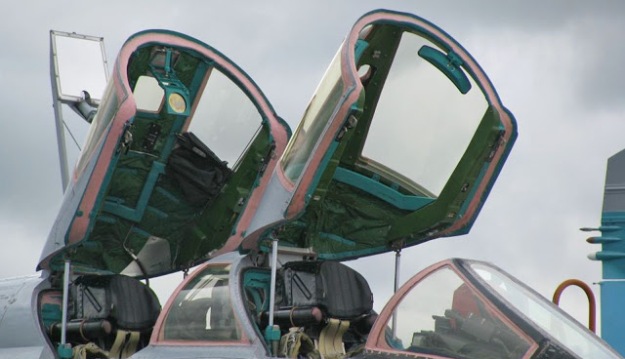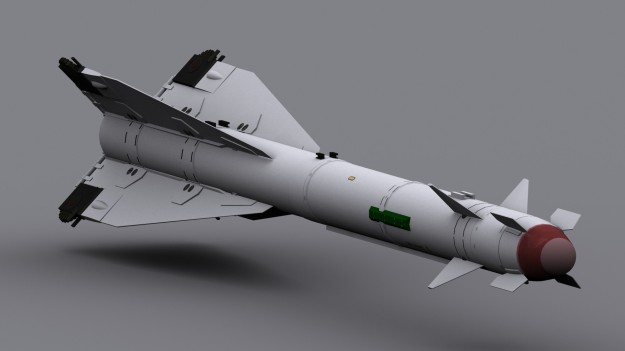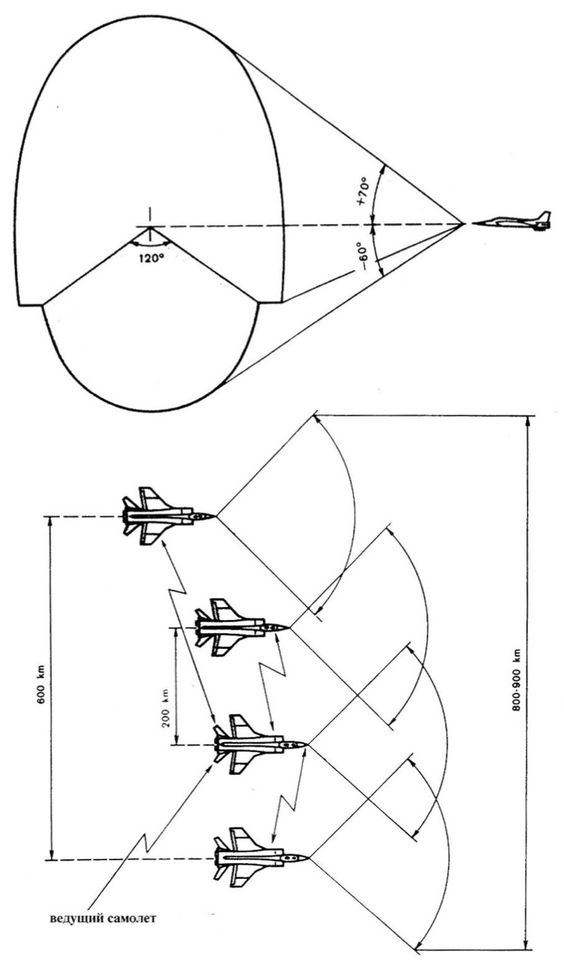A long-range supersonic interceptor aircraft, the MiG-31 Foxhound, a two-seat aircraft developed principally for the Russian and Kazakhstan Air Forces, was derived from MiG-25 Foxbat. The maiden flight of the MiG-31 took place in September 1975. Mikoyan is the designer and manufacturer of the MiG-31.
MiG-31 can work efficiently in all weather conditions while fulfilling visual flight rules (VFR) and instrument flight rules (IFR), day and night. It is equipped with state-of-the-art digital avionics. MiG-31 was the first soviet fighter aircraft to have true look-down and shoot-down capability.
Approximately 500 MiG-31 aircraft have been produced, out of which 370 were delivered to the Russian Air Force and 30 are in service with Kazakhstan Air Force. The remaining aircraft were upgraded to different variants under several upgrade programmes. Only some of the Russian MiG fleet have been upgraded to MiG-31BM standards under the upgrade programme.
Russian MiG-31 aircraft contract to Syria
In 2007, Russia’s United Aircraft Corporation (UAC) signed two contracts worth $1bn with Syria. One contract was for MiG-29M and another for MiG-31. The deliveries of MiG-29M are ongoing, but those of MiG-31 were not effective till 2009 when the UAC confirmed its plans to deliver the eight MiG-31 aircraft to Syria as part of the $1bn contract. The eight MiG-31 aircraft were ordered in a deal worth $400m signed in 2007. The order was cancelled in May 2009 due to pressure from Israel and lack of funds.
MiG-31 Foxhound development
The MiG-25 Foxbat was unable to fly at low altitudes. The installation of inefficient turbojet engines led to decrease in combat range at supersonic speeds and an increase in the speed gauge of the MiG-25 resulted in the destruction of the aircraft’s engine.
MiG-25 Foxbat
The MiG-25 Foxbat is a high-performance, high-altitude interceptor. There are several versions of this aircraft: A–basic interceptor; B–reconnaissance; C–two-seat trainer; D–reconnaissance with a modified radar and E. The Foxbat A aircraft, originally designed to counter high-altitude threats, has been converted to Foxbat E, providing a limited low-altitude look-down and shoot-down capabilities somewhat comparable to the MiG-23 Flogger. The wings are high-mounted, swept-back, and tapered with square tips. The aircraft has two turbojet engines and large rectangular air intakes below the canopy and forward of the wing roots. There are dual exhaust. The fuselage is long and slender with solid, pointed nose. The aircraft is box-like from the air intakes to rear section. It has a bubble canopy. On the tail are twin, sweptback, and tapered fins with angular tips. There are flats mid- to low-mounted on fuselage, swept-back, and tapered with angular tips.
Performance
The MiG-25 was capable of exceptional performance, including a maximum speed of Mach 3.0 and a ceiling of 90,000 ft (27,000 m) although a specially modified MIG-25 in 1977 flew to an altitude of 123,524 ft (37,650 m) in 1977. Some believed that the MiG-25 was designed against the SR-71 Blackbird, made to deter, or at least threaten the high altitude, high speed aircraft. However, its maneuverability, range, and close combat potential were extremely limited. Even its tremendous speed was problematic: although the available thrust was sufficient to reach Mach 3.2, a limit of Mach 2.83 had to be imposed to prevent destruction of the engines (at these speeds the engine would start to behave like a ramjet). Even Mach 2.83 was difficult to reach without overspeeding the turbines. The limited maneuverability of the Mig-25 (Maximum acceleration, g-load, rating was just 2.2 g with full fuel tanks, with an absolute limit of 4.5 g) has often been overstated by Western observers, as under the same high performance parameters, the SR-71 has even more restrictive stress limitations.
The maximum speed ever observed for a MiG-25 was Mach 3.2 as recorded by an American radar during a flight over Israel in 1973. The Soviet pilot was conducting a reconnaissance mission over the nation when he was threatened by Israeli surface-to-air missiles. The pilot went to full afterburner and pushed the MiG-25 as fast as it would go to return to the safety of an Egyptian airfield. Though the MiG-25 survived the flight, its engines were completely destroyed and had to be replaced. Source fighter-planes.com
| MiG-25PD Foxbat E Specification | ||
| Prime contractor: | Mikoyan-Gurevich Design Bureau | |
| Country of origin: | Soviet Union | |
| NATO codename: | Foxbat E | |
| Function: | High speed interceptor | |
| Crew: | 1 | |
| Year: | 1964 (base version) | |
| In-service year: | 1973 (base version) | |
| Power plant: | Two Soyuz/Tumansky R-15BD-300 afterburning turbojets | |
| Thrust: | 24,640 lb. each | 11,200 kg. each |
| Dimensions | ||
| Wing span: | 46 ft. | 14.02 m. |
| Length: | 78 ft.2 in | 23.82 m. |
| Height: | 20 ft. | 6.1 m. |
| Weight: | ||
| Empty | 44,000 lb. | 20,000 kg. |
| Max. takeoff | 80,784 lb. | 36,720 kg. |
| Performance | ||
| Ceiling: | 67,900 ft. | 20,700 m. |
| Speed: | 1,865 mph. | 3000 km/h. |
| Range: | 1,075 miles | 1,730 km. |
| Armament | ||
| Max. external weapons load of 4,000 kg. (8,800 lb.). Typical interceptor configuration: Four R-40 (AA-6 “Acrid”) AAMs., or two R-23 (AA-7 “Apex”) AAMs., and four R-60 (AA-8 “Aphid”) AAMs., or R-73 (AA-11 “Archer”) AAMs. |
||
| Known Variants | ||
| MiG-25BBT, MiG-25BM, MiG-25P, MiG-25PD, MiG-25PDS, MiG-25PU, MiG-25R, MiG-25RB, MiG-25RBF, MiG-25RBK, MiG-25RBS, MiG-25RBSh, MiG-25RBV, MiG-25RU, MiG-25U | ||
| Operators | ||
| Algeria, Azerbaijan, Belarus, Bulgaria, India, Iraq, Libya, Syria, Ukraine | ||
MiG-25 Technical data toad-design.com
In an effort to overcome the drawbacks of the MiG-25 Foxbat, the MiG-31 was developed to fly at low altitudes with required supersonic speeds. MiG-31 is equipped with efficient low-bypass-ratio turbofan engines, which allow an increase in combat range.
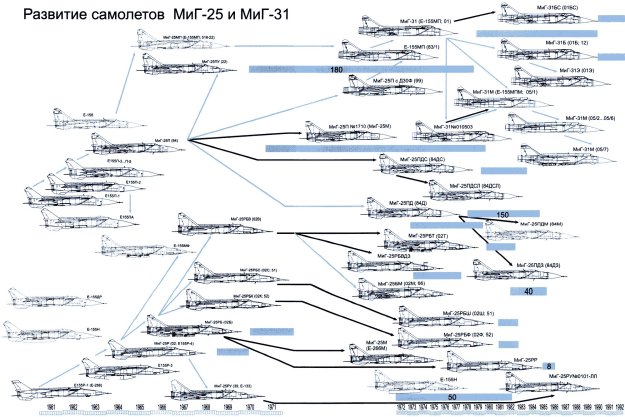 Image: testpilot.ru
Image: testpilot.ru
Production of MiG-31 began in 1979 and the aircraft was fully operational with the Soviet Anti-Air Defence (PVO) by 1982. The economic slowdown in the USSR has made the maintenance of its complex MiG-31 aircraft difficult for many squadrons. As a result, around 20% of the MiG-31 aircraft were removed from service. About 75% of these aircraft, however, re-entered service with the Russian Air Force in 2006 when strong economic growth returned.
MiG-31 & Develop Replacement: Here
 Artist impression of a MiG-31 replacement aircraft – Image: airrecognition.com
Artist impression of a MiG-31 replacement aircraft – Image: airrecognition.com
Russia Future PAK DP Long Range Interceptor: Here
Excerpt
The requirements for the new interceptor can be found on Russian websites which states the following:
… Speed newest Russian interceptor MIG-41, developed on the basis of MIG-31 should exceed Mach 4, said test pilot Anatoly Kvochur.
“This upgrade was to take place even 20 years ago. However, this did not happen, so now the requirements are increased. They are including in the (increasing) interceptor speeds of up to Mach 4-4.3 “- Kvochur said, RIA” Novosti “.
MiG-31 design
The MiG-31 has a highly aerodynamic and streamlined body to enable flying at high speeds at low altitude. The aircraft is specifically designed to track multiple targets simultaneously at high altitudes.
The MiG-31’s airframe contains various materials including welded nickel steel (49%), titanium (16%), aluminium alloy (33%) and 2% of composites. Four underwing pylons are also fitted in the fuselage of the aircraft.
 Image: testpilot.ru
Image: testpilot.ru
The aircraft’s fuselage is designed to provide lateral rectangular and diagonal cut air intakes and features a bubble canopy with a long pointed nose.
The wings are sharpened and swept back with square tips and negative slant.
Variants
The variants of MiG-31 include MiG-31A, MiG-31B, MiG-31BS, MiG-31E, MiG-31F, MiG-31BM, MiG-31FE, MiG-31LL, MiG-31M, MiG-31D and MiG-31S.
Commercial satellite launch variants MiG-31A and MiG-31S have been used to train astronauts, to conduct research in the upper atmosphere and for space tourism by launching the aerospace rally system rocket-powered suborbital glider.
MiG-31E is an advanced version of the MiG-31 supersonic interceptor aircraft. The variant is equipped with RP-31E airborne phased array radar. It can track ten, and destroy four, targets from long distances. Under normal and adverse weather conditions, the MiG-31E has the capacity to destroy aerial targets flying at 50m to 28,000m altitude in front and rear hemispheres.
In the absence of a ground air-defence system, the MiG-31E aircraft scans airspace at width of 900km-1,000km. An infrared (IR) seeker unit installed in the variant can track targets by its heat emissions in the passive mode of a blind attack.
MiG-31E
 Unit: unknown Serial: 903 (c/n.38401208786) MAKS’99 (Moscow Air Space Show), Moscow, 1999. Artist: © Yuriy Tepsurkayev Source: Авиа Галерея
Unit: unknown Serial: 903 (c/n.38401208786) MAKS’99 (Moscow Air Space Show), Moscow, 1999. Artist: © Yuriy Tepsurkayev Source: Авиа Галерея
The two-seat supersonic MiG-31E fighter is a combat aircraft which has no analogues over the world. It is capable:
– to combat in group air fights at the distances which are inaccessible for any other fighter over the world;
– to realize the network-centric methods of controlling the combat operations in air when engaging within heterogeneous grouping of warfare means;
– to perform the long-range flight with speed of 3000km/h (M=2.83) at high altitudes.
The MiG-31E aircraft is designed for intercepting and destroying high- and low-altitude targets in forward and rear hemispheres in uplook and downlook, VMC and IMC, day and night, in the passive and active jamming environment of the enemy.
The MiG-31E aircraft is the export version of the basic MiG-31 aircraft of the Russian Air Force.
The MiG-31E fighter-interceptor basic version has become the first serially produced fighter over the world which is equipped with airborne phased array radar.
The RP-31E phased array radar has a long detection range and simultaneous tracking of 10 air targets. The airborne radio-electronic equipment and armament allows the MiG-31E aircraft to intercept air targets of any types in the whole range of flight altitudes and speeds capable for aerodynamic vehicles (including cruise missiles flying at low altitude in the relief envelope mode) with possibility of simultaneous attack of four targets with long-range missiles.
Performance:
| Length, m | 21,62 |
| Wing span, m | 13,456 |
| Height, m | 6,456 |
| Take-off weight (maximum), kg | 46 200 |
| Maximum airspeed, km/h: | |
| – near ground | 1500 |
| – at high altitude | 3000 |
| Maximum M-number | 2,83 |
| Service ceiling, m | 20 600 |
| Maximum G-load | 5 |
| Service range with 4xR-33E and 2 drop tanks, km: | |
| – without in-flight refueling | 3000 |
| – with one in-flight refueling | 5400 |
| Engines | D-30F6 |
| Take-off thrust, kgf | 2х15 500 |
| Weapons: | |
| Number of external stations | 6 |
| “A-A” missiles: | |
| – long range | 4хR-3ЗE |
| – middle range | 2хR-40TD1 |
| – short range | 4хR-60MK |
| Built-in air gun, 30 mm | GSh-6-23M |
MiG-31E data migavia.ru
The MiG-31M is an advanced version of MiG-31. The variant was developed by upgrading the cockpit of MiG-31 with a number of cathode ray tubes (CRT) and an increased number of missiles.
MiG-31M
 Unit: unknown Serial: 057 17th produced MiG-31M. It was a first MiG-31M seen by western in 1992. Artist: unknown Source: www.combat-sim.net
Unit: unknown Serial: 057 17th produced MiG-31M. It was a first MiG-31M seen by western in 1992. Artist: unknown Source: www.combat-sim.net
In 1984, Yakovlev Design Bureau. AI Mikoyan began work on deep modernization of MiG-31. The emergence of new aircraft (the designation MiG-31M) was due to an increase in air defense fighter requirements. Based on the development of weapons, the purpose of air defense in the new environment was to protect areas from group raids strategic bombers with cruise missiles, long-range escort fighters escorted. In addition, it required to identify ways to intercept hypersonic, transatmosfernyh and space purposes. MiG-31M features an advanced, more powerful engines D-Zof-6M (h16500 kgf) and a new control system, weapons “Barrier-M” with a FAR of 1.4 m in diameter (radome radar axis is tilted down to 3 deg. 30 min ).
Radar complex has an increased range of detection of air targets, has the ability to simultaneously track up to 24 targets and direct missiles at six of them. The armament of the MiG-31M – UR six long-range P-ZZS and R-37, flown under the conformal fuselage two three rows and four medium-range missiles RVV-AE type under the wing. Cannon installation abolished. Increased the size of the fairing, which placed an additional 300 liters of fuel, the pilot cockpit canopy visor acquired besperepletnoe glazing, reduced cab glass area, increase the area of the wing root burls. Instead retractable teplopelengator by plane set IRSTS complex with IR and laser channels (its optical head is placed in front canopy cockpit). Individual protection systems and electronic countermeasures combined in airborne defense. Maximum take-off weight of the MiG-31M has increased to 52 000 kilograms, speed and altitude characteristics have not changed.
The first flight of an experienced fighter-interceptor MiG-31M took place on December 21, 1985 (the crew – a test pilot and navigator BA Orlov test LS Popov). Built six prototypes. In April 1994, Russian President has sent a message of congratulations to the creators of the MiG-31M and its weapons systems in the success of the world’s first test defeat on air targets at ranges in excess of 300 km. Translated by google – Source milrus.com
MiG-31BM is a high-speed multifunctional long-range fighter jet that can destroy both air and ground targets. The variant is equipped with upgraded avionics, hands-on-throttle-and-stick (HOTAS) controls, liquid-crystal colour multifunction displays (MFDs), a powerful on-board computer system, digital data links and a phased array radar. It has the capacity to intercept 24 targets simultaneously.
MiG-31D is an anti-satellite missile developed as part of the US ASAT (anti-satellite weapons) programme in 1987. It is fitted with single large missile beneath its fuselage and a special upward-looking radar. An associated intercept fire-control system is also equipped.
MiG-31D
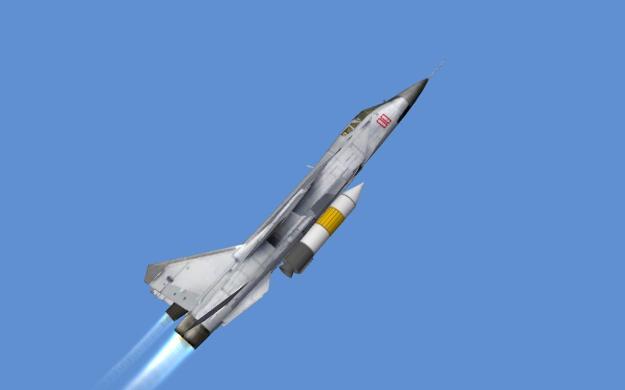
MiG-31D was created as a kind of response to the US ASAT program includes the development of a special modification of the F-15, which was launched aboard a two-stage solid-fuel missile capable of destroying spacecraft in orbit. It was designed based on serial MiG-31 with the use of certain new technical solutions implemented on the modernized MiG-31M. For a given directional stability of the aircraft with the large missile on the external load at the ends of its wings were large triangular washer. Construction of the first prototype (hull number 071, ie, “product 07”, 1-car) was completed by the end of 1986, and January 17, 1987 the crew of a test pilot OKB. AI Mikoyan Aviarda Fastovtsa and shgurmana-test Leonid Popov picked it up in the first flight. A year later, it was ready and the second prototype (№072), the first to fly around April 28, 1988 Anatoly Kvochur and Leonid Popov.
By the early 90-ies. phase of flight tests had been completed, and both cars were transferred for further testing to the landfill, “Sary-Shagan” on the western shore of Lake Balkhash in Kazakhstan, where traditionally held testing of all new Soviet missile systems and air defense missile.
According to a recently published monograph “Russian Weapons missile defense: the heroic epic of the creation and defense of the triad pioneers – the creators and testers” (Moscow, 2006), “work on the preparations for the SSP system 30P6 test against low-orbit satellites” were deployed at the site even in 1985, “Until this issue PKO landfill engaged within the ABM objectives, as One of the tasks of system A-35 and A-135 are hitting low-orbit satellites. However, due to the fixed version, these systems have limited capacity and can solve the problem of the SSP as a private, within the lesion missiles to intercept long-range area, “- says in the book. “Intensive work on the deployment and testing of the system 30P6 funds were up until 1995, and generally obtained valuable results”, – concluded the authors of the monograph.
However, to complete these tests it failed: at the end of 1991, the Soviet Union ceased to exist, and both the MiG-31D appeared on the territory of the Republic of Kazakhstan became a sovereign. Two built MiG-31D have been preserved in one of the hangars airfield ground “Sary-Shagan” near Priozersk (it was his and visited in August 2003, Prime Minister of Kazakhstan Daniyal Akhmetov). Oblivion “zero Seventh” went on for almost ten years, until finally they were in demand – in the framework of a purely civil, “Ishim” commercial project. Translated by google – Source coollib.net
MiG-31BM to deploy anti-satellite missile: Here
Vympel 79M6 / 30P6 “Contact” missile
 The aircraft carrier MiG-31D aircraft number 072 and 79M6 missile (left) at the Sary-Shagan. Source авиару.рф
The aircraft carrier MiG-31D aircraft number 072 and 79M6 missile (left) at the Sary-Shagan. Source авиару.рф Rocket 79M6 “Contact” under the MiG-31D. Drawing. Source авиару.рф
Rocket 79M6 “Contact” under the MiG-31D. Drawing. Source авиару.рф
MiG-31 aircraft conducted tactical doctrine for interception of supersonic cruise missile fire in the stratosphere – Video
MiG-31 may get further upgrade: Here
MiG-31K
Russian Mach 10 hypersonic air-to-surface missile “Kinzhal” (Dagger) – Video
Russian Kinzhal hypersonic missile is a modified Iskander-M: Here
KH-47M2 Kinzhal nuclear-capable, Russian air-launched ballistic missile
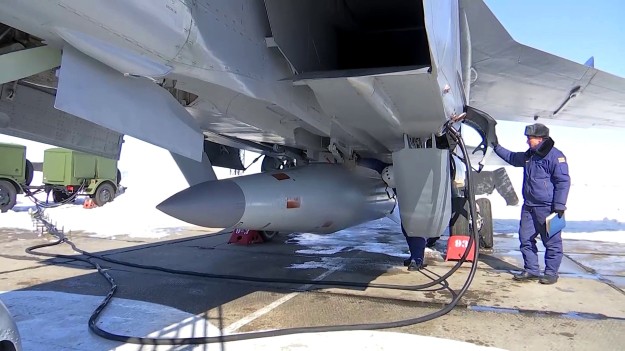
tellerreport.com
The Kh-47M2, also nicknamed “Kinzhal” (Dagger), is a new Russian air-launched cruise missile. Some sources report that this missile is hypersonic. Since 2017 this missile was tested and evaluated by the Russian military. This missile was first publicly revealed in 2018. By 2018 only a small number of these missiles were built for trials and evaluation. In 2018 a total of 10 MiG-31K long-range multi-role fighters were fitted with these missiles and were used operationally. Currently there is little known about this missile and its capabilities. Interestingly, there is no information available on the original Kh-47 missile, rather than its improved “M2” version.

redstar
The Kinzhal resembles an air-launched version of the Iskander short-range ballistic missile. However despite similar appearance it is a completely different design. The Kh-47M2 Kinzhal is a long-range standoff weapon. Its role is to suppress hostile defenses and engage important targets. It can also engage hostile warships, such as aircraft carriers, cruisers and destroyers.

redstar
The Kinzhal missile is carried and launched by MiG-31K long-range multi-role fighters. It is planned that it will be also carried by a new Su-57 stealthy multi-role fighters. Source military-today.com

missilethreat.csis.org

weaponews.com
Cockpit
The MiG-31 cockpit is equipped with digital avionics such as MFDs and liquid crystal displays (LCDs), which provide updated instrument readings and radar information.
Both front and rear sides of the cockpit are equipped with zero / zero ejection seats which allow the pilot to fly at the altitude and airspeed preferred. The pilot sits in the front seat of the cockpit while the weapon system officer (WSO) sits in the rear cockpit seat, controlling the radar operations and weapon deployment thereby decreasing the work load of the pilot and increasing the efficiency.
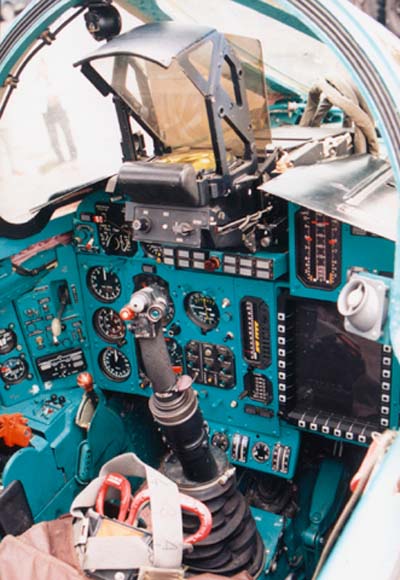 Pilot
Pilot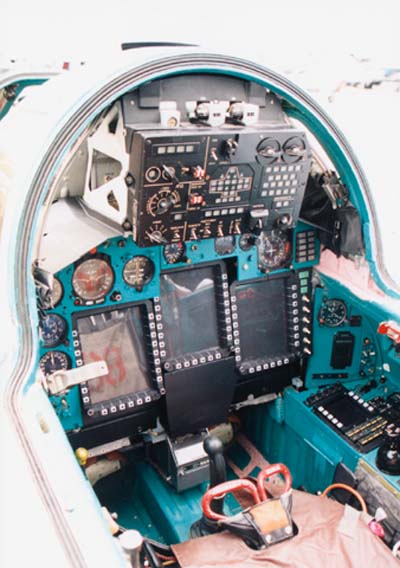 Weapon system officer (WSO)
Weapon system officer (WSO)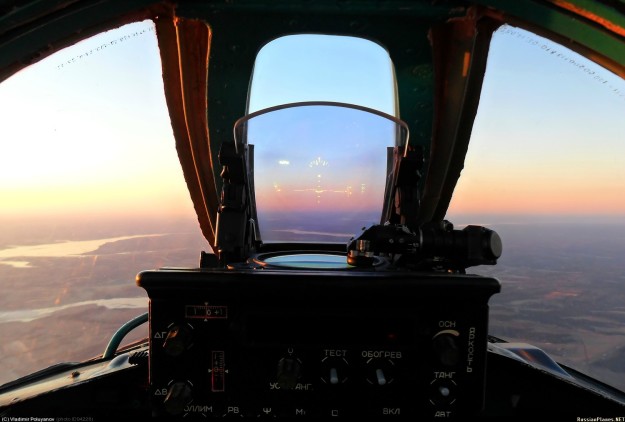
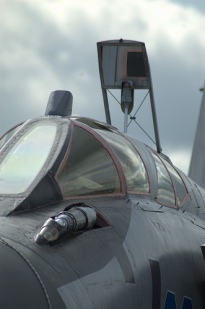

KD-36DM ejection seats
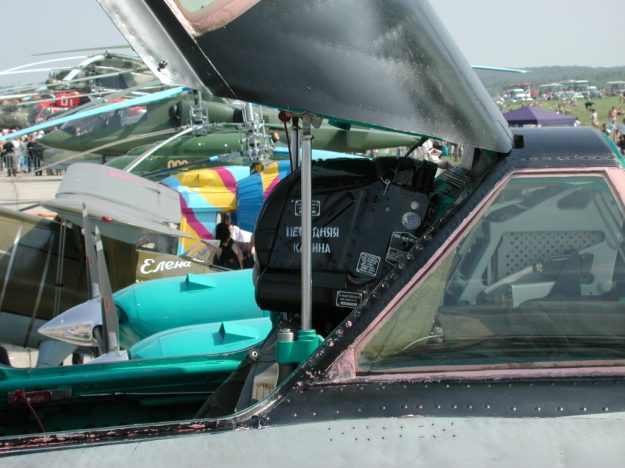
Armament
Four long-range Vympel R-33E air-to-air missiles are installed in the MiG-31 aircraft. The R-33 can be launched in inertial navigation mode to shoot the target at extreme range. It can be guided in semi-active radar homing (SARH) mode for initial acquisition and mid course updates. It is used for attacking large and high-speed targets such as the SR-71 Blackbird, the B-1 Lancer bomber, and the B-52 Stratofortress.
How the Mig-31 repelled the SR-71 Blackbird from Soviet skies: Here
B-1 Lancer bomber: Details
The aircraft is also equipped with four short-range R-60MK missiles and two Bisnovat R-40TD1 medium-range missiles. A six-barrel 30mm internal cannon (Ghs-6-23M) is installed above the starboard main landing gear bay of the MiG-31 aircraft. The cannon contains 800 rounds of ammunitions and can fire at a rate of over 10,000 rounds a minute.
MiG-31BM can accommodate the AA-12 Adder missile and various Russian air-to-ground missiles (AGMs) such as the AS-17 Krypton anti-radiation missile (ARM).
Armament details
The MiG-31’s main armament is four R-33 air-to-air missiles (NATO codename AA-9 ‘Amos’) carried under the belly. The R-33 is the Russian equivalent of the U.S. Navy’s AIM-54 Phoenix.
- 1× GSh-6-23 23 mm cannon with 260 rounds.
- Fuselage recesses for 4× R-33 (AA-9 ‘Amos’) or 6x R-37 (AA-13 ‘Arrow’) (MiG-31M/BM only).
- 4 underwing pylons for a combination of (6 places for charging (+ 2 space to add removable fuel tanks)):
- 6× R-37 (missile) long-range missiles (280 km).
- (4)× R-33 (missile) long-range missiles (304 km) 2012.
- (?)× Kh-31 long-range missiles (200 km) for high-speed target (maneuvering with overload 8G).
- (?)× Р-33 AA-9 «Amos» (1981) 120 km, Р-33S (1999) 160 km.
- 2 4 (superior limit) × R-40TD1 (AA-6 ‘Acrid’) medium-range missiles (P-40 (50 km, MiG-25P, 1970) 80 km(PD)(user)), height applications between 0.5 and 30 km (maneuvering with overload 4 g).
- 4× R-60 (AA-8 ‘Aphid’)
- 4× R-73 (AA-11 ‘Archer’) short-range IR missiles,
- 4× R-77 (AA-12 ‘Adder’) medium-range missiles (100км) for high-speed target (maneuvering with overload 12G).
- Some aircraft are equipped to launch the Kh-31P (AS-17 ‘Krypton’) and Kh-58 (AS-11 ‘Kilter’) anti-radiation missiles in the Suppression of Enemy Air Defenses (SEAD) role. Anti-ship Kh-31A (up to six), missiles air-to-surface X-59 and X-29T (up to three) or X-59M (up to two units), up to six air bombs KAB-1500, or up to eight KAB-500 with a television or laser-guided. Maximum weight of the combat load is 9000 kg. Source wikiwand.com
1 x 30mm internal cannon (Ghs-6-23M)
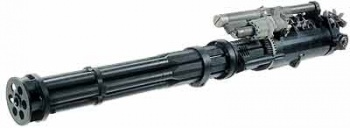
The Gryazev-Shipunov GSh-6-23 (GRAU designation: 9A-620 for GSh-6-23, 9A-768 for GSh-6-23M modernized variant) is a powerful, fast-firing six-barreled 23 mm Gatling gun used by some modern Soviet/Russian military aircraft.
The GSh-6-23 uses the 23×115 Russian AM-23 round, fed via linked cartridge belt or a linkless feed system. The linkless system, adopted after problems with the belt feed, is limited to 8,500 rpm. Fire control is electrical, using a 27v DC system. The cannon has 10 pyrotechnic cocking charges, similar to those used in European gas-operated revolver cannons such as the DEFA 554 or Mauser BK-27.
The GSh-6-23 has an extremely high rate of fire, with maximum cyclic rates of 9,000 to 10,000 rounds per minute. Compared to the U.S. M61 Vulcan, the GSh-6-23 fires 50-66% more rounds per minute, has a heavier projectile, but lower muzzle velocity. The weapon is also lighter and shorter. The rapid rate of fire exhausts ammunition quickly: the MiG-31(800 rounds maximum) aircraft, for example, with 260 rounds of ammunition, would empty its magazine in less than two seconds.
| SPECIFICATIONS | |
|---|---|
| WEIGHT | 73-76 kg (161-167 lb) |
| LENGTH | 1.4 m (4 ft 7 in) |
| HEIGHT | 18 cm (7 in) |
| CARTRIDGE | 23×115mm AM-23 |
| BARRELS | 6, Rifled |
| ACTION | Gatling, Gas-operated |
| RATE OF FIRE | 10,000 rpm |
| MUZZLE VELOCITY | 715 m/s (2345 ft/s) |
| FEED SYSTEM | Belt or linkless feed system |
Source warfareequipment.blogspot.com
R-33 (AA-9 ‘Amos’) air-to-air missile
The R-33E is a long range, air-to-air missile designed to be the weapon of choice for the Mig-31 air defense aircraft against highly valuable airborne threats such as strategic bombers and high altitude aircraft. It is capable of operation into heavy jamming environments and all weather conditions. Its ranges varies according to some reports from 120 km to 160 km depending on the launch altitude and airspeed.
Once launched, the R-33 missile uses an inertial navigation and a semi-active radar system for midcourse guidance. In the terminal phase of the flight an active radar homing head is responsible for the missile guidance and target interception. The Mig-31 Foxhound is the sole aircraft enabled to use the R-33E missile.
Dimensions
Diameter: 380 millimeter
Length: 4.15 meter (13.6 foot)
Wingspan: 0.90 meter
G-load
Target’s Max Load Factor: 4 g
Performance
Max Range: 120 kilometer (65 nautical mile)
Target’s Max Altitude: 25,000 meter
Target’s Min Altitude: 50 meter
Speed
Target’s Max Speed: 3,000 kph (2.51 mach)
Top Speed: 4.50 mach (5,380 kph)
Weight
Warhead: 47 kilogram
Weight: 490 kilogram (1,080 pound)
Source deagel.com
R-60 (AA-8 ‘Aphid’) air-to-air missile
The Molniya (now Vympel) R-60 (NATO reporting name: AA-8’Aphid’) is a short-range lightweight infrared homing air-to-air missile designed for use by Soviet fighter aircraft. It has been widely exported, and remains in service with the CIS and many other nations.
| Type | Short-range air-to-air missile |
| Place of origin | Soviet Union |
| Service history | |
| In service | 1974- present |
| Production history | |
| Manufacturer | Vympel |
| Specifications | |
| Weight | 43.5 kg (96 lb) |
| Length | 2,090 mm (6 ft 10 in) |
| Diameter | 120 mm (4.7 in) |
| Warhead | 3 kg (6.6 lb) |
| Detonation mechanism |
proximity |
| Engine | solid-fuel rocket engine |
| Wingspan | 390 mm (15 in) |
| Operational range |
8 kilometres (5.0 mi) |
| Flight altitude | 20,000 m (66,000 ft) |
| Speed | Mach 2.7 |
| Guidance system |
infrared homing |
Source wikiwand.com
R-40TD1 (AA-6 ‘Acrid’) medium-range missiles air-to-air missile
R-40 (AA-6 ‘Acrid’) MVR AAM long-range air-to-air missile Mach 4.5-5 R-40 is the largest air-to-air missile to ever enter production. Standard PVO procedure was to fire a 2-missile salvo at a target; 1 heat-seeking R-40T missile followed by a SARH R-40R, in order to avoid the possibility of the heat-seeking missile locking-on to the radar-guided missile.
R-77 extended medium range air-to-air missile
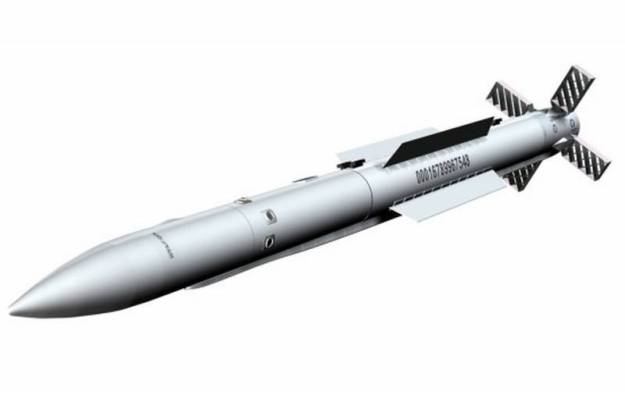
The R-77, RVV-AE designation used for the export market and AA-12 Adder designation used by Western intelligence, is an extended medium range air-to-air missile featuring an active radar seeker to engage multiple airborne targets simultaneously. This missile was designed as the Soviet/Russian counterpart to the United States Air Force AIM-120 AMRAAM. The R-77 enables the Mig-29 and Su-27 fighter aircraft families to engage multiple airborne threats simultaneously thanks to its fire and forget capability. There are other versions fitted with infrared and passive radar seekers instead of active radar homing. Future plans call for increasing the missile range well beyond 150 kilometers.
The R-77 has been designed with innovative control surfaces which are one of the keys of its impressive performance. Once launched, the R-77 depends on an inertial navigation system with optional in-flight target position updates from the aircraft sensors. When the R-77 missile is at a distance of about 20 km its radar homing head activates leading the missile to its target.
Dimensions
Diameter: 200 millimeter
Length: 3.60 meter (11.8 foot)
Wingspan: 350 millimeter
Performance
Max Range: 80 kilometer (43 nautical mile)
Target’s Max Altitude: 25,000 meter
Target’s Min Altitude: 20 meter
Speed
Top Speed: 4 mach (4,782 kph)
Weight
Warhead: 30 kilogram
Weight: 175 kilogram (386 pound)
R-77 data deagel.com
Vympel R-37M extremely long-ranged air-to-air missile

The R-37 (Western designation: AA-13 Arrow, although sometimes AA-X-13 Arrow) is a large, fast, powerful, and extremely long-ranged Russian air-to-air missile. Vympel, a sizeable research and production company, (now part of TRV) designed and built the R-37.
The R-37 was developed to replace the R-33 (Western designation: AA-9 Amos), which was used on the MiG-31. Its main purpose is to shoot down aircraft (particularly high value AWACS—Airborne Warning And Control System—aircraft) and possibly even cruise missiles from such long range that the launch platform is safe from retaliation.
A council of ministers in the USSR started the development of the R-37 in 1983. Testing began six years later in 1989. In 1994, the K-37 (the R-37’s name in development) secured a kill and a record at the same time by hitting its target from 300 kilometers. However, in 1998, the K-37 program was dropped due to its high cost and lack of enough suitable MiG-31 launch platforms. But, in 2006, the Russian government restarted the weapon’s development as part of the MiG-31BM program. The new version is known as R-37M or RVV-BD. It is unknown if this missile has entered service yet, although according to some sources it entered production in 2014.

The R-37M is believed to track its targets with both semi-active and active radar homing. Its radar system is the 9B-1388. The R-37M probably homes on its targets in this way: first, the launch platform detects its target and launches the R-37 towards the target’s hypothesized position. Once the R-37M comes within suitable range of the target, it activates its own radar and homes in on the target. The R-37M can also use a fire-and-forget mode where it is completely independent of its launch platform.
The recent R-37M is a powerful and effective missile. It is much more maneuverable than its predecessor, the R-33. It can engage targets from any altitude between 15 and 25 000 meters, giving it great versatility. Its high explosive fragmentation warhead is huge—60 kilograms—and capable of critically damaging even large AWACS aircraft. It has an incredibly fast speed—Mach 6 or about 7,350 km/h, which is enough to easily catch up with every type of aircraft. Above all, it reportedly has an enormous range— of up to 200.

Although normally called the R-37, this missile has many other names. In the West it is designated as the AA-X-13, AA-13, Arrow, or even Andi. In Russia, it is also known as the Izdeliye 610 or RVV-BD (Raketa Vozduh-Vozduh Bolyshoy Dalnosty or English for Long-Range Air-to-Air Missile).
It appears that the R-37M will be used on two types of aircraft. The first is the MiG-31BM, an extremely fast interceptor aircraft. The second is the Su-35S, a powerful multi-role fighter.
| R-37M RVV-BD | |
| Country of origin | Russia |
| Entered service | 2016 (?) |
| Missile | |
| Missile length | 4.06 m |
| Missile diameter | 0.38 m |
| Fin span | 1.02 m |
| Missile launch weight | 510 kg |
| Warhead weight | 60 kg |
| Warhead type | Conventional |
| Range of fire | up to 200 km |
| Guidance | semi-active and active radar homing |
Source military-today.com
Kh-31AD & Kh-31PD (AS-17 Krypton)

The Kh-31, AS-17 Krypton NATO-codename, is an advanced, long range, highly supersonic missile designed to withstand countermeasures effects. The Kh-31 propulsion system consists of a solid-fuel rocket engine which accelerates the missile to Mach 1.8 airspeed. Then this engine is dropped and a jet engine ignites using the missile’s within space as a combustion chamber. The missile accelerates to Mach 3+ thanks to the jet engine.
Kh-31AD airborne anti-ship guided missile

Kh-31AD airborne anti-ship guided missile is designed for hitting combat (assault landing) surface ships and cargo ships from the striking force (convoys) and single ships. This particular missile has a warhead power increased to 15% in compare with its prototype Kh-31A. Launch range is increased up to 120-160 km almost in two times.
Performance:
| Maximum launch range | |
| (carrier flight parameters: H=15 km, M=1.5 km), km | 120 to 160 |
| Launch altitrudes, km | 0,1 to 15 |
| Launch speeds (M number) | 0,65 to 1,5 |
| Aiming system | inertial + active radio homing head |
| Active radio homing head angle of sight in vertical plane, degree | +10 to -20 |
| Active radio homing head angle of sight in horizontal plane, degree | up to +/-27 |
| Warhead: | |
| type | universal |
| weight, kg | 110 |
| Fuel | gasoline |
| Missile start weight (maximum), kg | 715 |
| Lengthxdiameter, m | 5,340×0,360 |
| Weather conditions for use | any conditions at sea roughness |
| up to 4-5 | |
| Carriers | aircrafts Su-30MK (MKI, MKM, MK2), |
| Su-35, Mig-29K, Mig-29KUB, Mig-35 | |
| and etc. | |
| Average number of missile hits required to make enemy’s destroyer | |
| ineffective | 2,0 |
Kh-31PD airborne high speed anti-radar missile
Kh-31PD airborne high speed anti-radar missile is designed to hit radars of anti-aircraft missile stations (ZRK).
Missile ground maintenance is provided by the OKA-E-1 aircraft guided weapons (AUSP) preparation system.
Performance:
| Maximum launch range, km | |
| (carrier flight parameters H=15km, M=1,5), km | 180 to 250 |
| Maximum launch range (H=0,1km), km | 15 |
| Launch altitudes, km | 0,1 to 15 |
| Launch speeds (M number) | 0,65 to 1,5 |
| Aiming system | inertial + wide waveband range |
| passive radio homing head | |
| Target location angle when launching, degree | |
| target lock being under carrier | +/-15 |
| target lock at the trajectory | +/-30 |
| Warhead: | |
| type | cluster, universal |
| weight | 110 |
| Fuel | gasoline |
| Missile start weight (maximum), kg | 715 |
| Missile overall dimensions: | |
| lengthxdiameterxwing span, m | 5,340×0,360×0,954 (1,102) |
| Weather conditions | any weather conditions |
| Carriers | aircraft Su-30MK (MKI, MKM, MK2), |
| Su-35, Mig-29, Mig-35, Mig-29KUB and etc. |
Source ktrv.ru
Kh-58 (AS-11 ‘Kilter’) anti-radiation missiles
Kh-58 (Izdeliye 112) – original version for the Su-24M
The Kh-58E missile is designed to engage radars making part of land-based air defence systems, air defence early warning, target designation and control systems, and other emitting targets operating in A/A’, B/B’ and C frequency bands.
The Kh-58E missile can be employed in any weather conditions (rain, snow, fog) or season, without any restrictions on geographical latitude of the launch site.
The missile is guided by a passive radar homing head and an autonomous control system.
The Kh-58E missile can be employed in weapon systems of the Su-24MK, Su-22M4, Su-25TK, MiG-25BM type combat aircraft equipped with an appropriate target designation system and airborne ejection unit for missile’s launch.
Developer and manufacturer: “Raduga” State Machine-Building Design Bureau
Performance:
| Max range | |
| (depends on launch altitude at max speed), km | 46-200 |
| Launch altitudes, km | 0,2-20 |
| Launch speeds, Mach number | 0,47-2,35 |
| Min launch range, km | 8-60 |
| Missile launch weight, kg | 650 |
| Warhead weight, kg | 149 |
| Missile dimensions, m: | |
| length | 4,8 |
| body diameter | 0,38 |
| wing span | 1,17 |
Source ktrv.ru
Performance
The MiG-31 can climb at a rate of 208m a second and has the capacity to fly at 3,000km/h. The ferry and combat ranges of the aircraft are 3,300km and 720km respectively. The maximum take-off weight of the aircraft is 46,200kg. The cruise range and wing loading capacities are 1,620m and 665kg/m² respectively, while the maximum g-load is 5g.
Radar
The MiG-31 aircraft is equipped with world’s first electronically scanned N007 Zaslon phased array radar. It is also known as SBI-16 Zaslon (Flash Dance) radar and operates from the rear cockpit by WSO. It can receive signals from early warning radar (EWR) and airborne warning and control systems (AWACS). Zaslon has the capacity to scan 200km distance. The radar can trap ten targets and engage four simultaneously flying in the surrounding radius of the aircraft (behind and below the aircraft).
The antenna of Zaslon is fixed and can be moved electronically. The electronic steering of the radar beam is much faster and accurate than mechanical steering.
 Evgeniy Topgun
Evgeniy Topgun
The Zaslon radar has the capacity to search and attack various targets in air and ground using continuous and discontinuous fields of control and guidance commands despite target defensive manoeuvres, electronic counter measures (ECM) and adverse weather conditions.
N007 Zaslon phased array radar/SBI-16 Zaslon (Flash Dance) radar
Weapon control system (WCS) “Zaslon” is intended for search, detection, identification and tracking of air targets in FWD and TAIL hemispheres, in look-up and look-down modes, in the presence of jamming. WCS “Zaslon” is mounted on MiG-31aircraft and its upgrades intended for air target interception at long ranges, single and group operations, interaction with ground automatic control systems and ACS
Performance characteristics
| №№ | Name | Characteristics |
| 1 | Weapon control system, including: | WCS “Zaslon” |
| – | On-board digital computer | «Baget 55.06.08» |
| – | Three-channel analog receiver | B3 |
| – | Phased antenna array with electronic beam scanning | B1 |
| – | Transmitting device | B2 |
| – | On-board equipment interface system | |
| – | System of objective control | |
| 2 | Radar type | Pulse-Doppler radar |
| 3 | Pulse repetition frequency | high |
| 4 | In “Air-to-Air” mode the radar provides as follows: | |
| – | Simultaneous tracking | 24 targets |
| – | Simultaneous attack | 8 targets |
| – | Air target illumination and transmission of radio-correction commands to control semi-active missile RHH | |
| – | Identification Friend-or-Foe | |
| – | Operation under ECCM conditions | |
| – | Coordinate measuring and attack of a jammer | |
| – | Detection and tracking zone in azimuth | ±60 degrees |
| – | Detection and tracking zone in elevation | ±35 degrees |
| – | Detection range of an air target of bomber type (RCS=19m2, with 0.5 probability) in FWD hemisphere | 200 km |
| – | Detection range of an air target of fighter type (RCS=3m2, with o.5 probability) in TAIL hemisphere | 35 km |
| – | Operation range of radio-correction channel | |
| – | Target detection upon its heat radiation | 56 km |
| 5 | Head-up display system | PPI-70B (ППИ-70В) |
| 6 | IFF system interrogator | |
| 7 | Data-exchange system | APD-518 (АПД-518) |

Application
Interception and destroying of air targets flying at altitudes of 50 – 28000 meters in FWD and TAIL hemispheres, including look-down mode, under heavy weather, while maneuvering and in the presence of active and passive jamming
A group of four MiG-31s is capable of exchanging data in automatic mode regarding targets being tracked within 800km-wide sector being 2000 km distant from a ground command post and transmitting target data to a ground- or air-based command post.
MiG-31 fighter is capable of homing up to three MiG-23, MiG-29, Su-27 aircraft in targets with radars of these aircraft being Off.
Weapon control system as a part of MiG-31 aircraft provides for application of R33E, RVV-AE, R-73E weapons.
Source niip.ru
RK-RLDN and APD-518 digital secure datalinks
The MiG-31 was equipped with RK-RLDN and APD-518 digital secure datalinks. The RK-RLDN datalink is for communication with ground control centers. The APD-518 datalink enables a flight of four MiG-31 to automatically exchange radar-generated data within 200 km (124 mi) from each other. It also enables other aircraft with less sophisticated avionics, such as MiG-23,25,29/Su-15,27 to be directed to targets spotted by MiG-31 (a maximum of 4 (long-range) for each MiG-31 aircraft). The A-50 AEW aircraft and MiG-31 can automatically exchange aerial and terrestrial radar target designation, as well as air defense
Corner area of simultaneous firing rockets number of goals for the MiG-31 is 18200 square degrees (for the F-14 is only 420 square meters °). long-range missiles can be induced at a target in a range of slightly less than +/- 120 degrees (F-14 only +/- 20). Source wikiwand.com
Example above: APD-518 datalink enables a flight of four MiG-31 to automatically exchange radar-generated data within 200 km (124 mi) from each other a group of four MiG-31 interceptors is able to control an area of air space across a total length of 800 km
- arming – 4 long-range missiles + 4 short-range/medium-range missiles (including R-77 medium-range).
- interacting with ground-based automated digital control system (ACS «Rubezh» Operating radius of 2000 km, can control multiple groups of planes), operating modes remote aiming, semi-automated actions (coordinate support), singly, and also: to direct on the target missiles launched from the other aircraft.
- Digital immune system provides the automatic exchange of tactical information in a group of four interceptors, remote one from another at a distance of 200 km and aiming at the target group of fighters with less-powerful avionics (in this case the aircraft performs the role of guidance point or repeater).
Norwegian F-16 versus Russian MIG-31
Sensors
MiG-31 is equipped with light duty (LD) / speed and direction (SD) sensor, track while scan (TWS) radar, infrared search and track (IRST) system and radar warning receiver (RWR) system. The aircraft assigns partial power to track targets and the remaining to scan. The TWS radar system in the aircraft uses two new technologies – phased array radars and computer memory devices.
IRST sensor 8TK
 8TK pod is semi-recessed under the MiG-31’s nose – Image: aerospace.boopidoo.com
8TK pod is semi-recessed under the MiG-31’s nose – Image: aerospace.boopidoo.com
Semi-retractable IRST of MiG-31. Field of view of sensor is ±60° azimuth, +6/-13° elevation. Range is about 50 km against a tail-on aspect target in military power.
The IRST sensor detects and tracks jet aircraft and helicopters that emit infrared rays, while the RWR systems detect radar systems emitting radio waves through the ground or in the air. The RWR comprises a visual display unit (VDU) in the cockpit that monitors radars by producing audible sounds.
Engines
MiG-31 supersonic aircraft is equipped with two Solovyev D-30F6 turbofan shaft engines with a take-off thrust 15,500kgf each. The dry thrust of the D-30F6 is 9,500kgf for each engine. The engine provides a maximum speed of Mach 1.23 at low altitude and increases the aircraft’s range. The fuel consumption of the MiG-31 is very high compared to other aircraft, principally due to its multiple roles.
Air intake has adjustable flaps
 Телеканал Звезда
Телеканал Звезда
D30-F6 jet engines
 D-30F6 – Image: leteckemotory.cz
D-30F6 – Image: leteckemotory.cz
D-30F6 is military two-shaft, two-spool engine with mixed afterburner chamber for both inner and outer flow and with regulable exhaust nozzle. Engine is intended to be used on supersonic interceptors and fighter-bombers MiG-31. Soloviev’s design team from Perm started the developement in 1972. The team comprised of two companies – Aviadvigatel and Motorstroitel. The developement was finished in 1980. As can be seen from the engine’s name the engine was based on D-30 line from Il-62M and Tu-154M passenger planes. Two-spool scheme significantly lowers the specific fuel consumption on dry thrust thus significantly increases range od MiG-31 against it’s predecessor, the MiG-25. Neverthenless the engine gives the plane a good altitude-speed characteristics also – top speed 3000 km/h, operation altitude 11 to 21 km and as can be seen in some sources low level flight speed 1500 km/h. Another advantage of this scheme is lower thermal radiation inside the plane’s fuselage. Interesting thing is that this allowed to remove the 5 kg heavy silver coating of thermal shield around engines which was used on MiG-25. The D-30F6 is the first soviet two-spool engine with afterburner. It proved it’s reliability in wide range of weather conditions during it’s more than 25 years long operation service.
Construction
Construction scheme is modular, consist of 7 modules. All the modules (except for base) can be replaced during service.
- inlet guide vanes
- 5-stage low-pressure compressor
- base module – separating case, 10-stage high pressure compressor (movable vanes of first stator stage, air bleed after 4th and 5th stage), tube-annular combustion chamber with 12 burners, 2-stage hight pressure turine, 2-stage low pressure turbine (both cooler by air from the compressor), rear support
- mixer case
- afterburner with four ring flame stabilisers
- jet nozzle with variable cross-section
- unit of a forward and back accessory box assembly
 Unmounted D-30F6 engines – Image: Vitaly V. Kuzmin
Unmounted D-30F6 engines – Image: Vitaly V. Kuzmin
Reliability of the engine is provided by protection, back-up and diagnostics systems:
- low pressure rotor maximum speed limitation system and maximum turbine exit temperature limitation system;
- safety system against turbine overspeed (drive of constant revolutions);
- anti-icing system for the cowl and blades of inlet guide vanes;
- anti-surge system.
Electronic-hydraulic system of automatic engine control is duplicated by hydraulic system ensuring safety of flight and back-up function in case of electronic system malfunction. The design of the engine provides an opportunity of the parametric control of its condition aboard of the airplane. To evaluate the condition of the air and gasflowpath parts in service, the engine design provides for the inspection of all compressor and turbine blades, and also, nozzle vanes of both high pressure turbine stages.
In case of foreign objects ingestion into the engine, the design allows to replace in service separate damaged blades of the 1-st high pressure compressor stage and the entire module of low pressure compressor
Besides the original D-30F6 for MiG-31 there were a few modifications also, among others the engine for experimental twin-engine S-37 (Su-47) prototype and high altitude subsonic twin-engine M-55 plane. In the first case the engine is sometimes designates as D-30F11, the information is not confirmed. The second case engine was unaugmented D-30V12 derivate with 9000 kp (88,2 kN) of thrust. M-55 plane took of in 1988 for the first time. The engines ran reliably in extreme conditions with air temperature of -92°C. Some other variants which probably existed only on papers were to equip 5th generation fighters. They had to have increased thrust among other improvements.
| Maximal thrust (H=0, M=0, t=15°C) | 9500 kp (93,16 kN) |
| Full afterburner thrust (H=0, M=0) | 15500 kp (152 kN) |
| Specific fuel consupmtion on maximal thrust | 0,72 kg.kp-1.h-1 |
| Specific fuel consumption with full afterburner | 1,9 kg.kp-1.h-1 |
| Maximal turbine inlet temperature | 1387 °C |
| Air flow | 150 kg.s-1 |
| Pressure ratio on low pressure compressor | 3 |
| Pressure ratio on high pressure compressor | 7,05 |
| Overall pressure ratio | 21,15 |
| Bypass ratio | 0,57 |
| Inlet diameter | 1020 mm |
| Length | 7040 mm |
| Dry mass | 2416 kg |
| Maximal operation speed | M=2,83 |
One source mentions yet another thrust parameter “Frontal (max)” in value of 18980 kp (186,1 kN). I’m not sure what this means exactly.
Operators: Here

Engine source leteckemotory.cz
Main material source airforce-technology.com
Images are public domain unless otherwise stated
Main image Sergey Boldenkov
Revised Jan 29, 2017
Updated Mar 20, 2021








